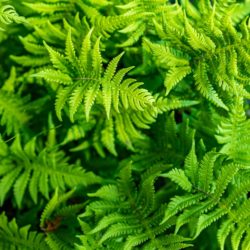Etymology
Phegopteris is Greek for beech (phegos) and fern (pteris), and may relate to a habitat in Europe; connectilis is Latin for fasten together, which may be a reference to the wing on the fern stem (rachis) that connects all the leaflets except the down-turning, lowest leaflets (pinnae).
Native Habitat
Moist, humusy, acidic soils.
Garden Uses
Naturalizes as a groundcover in cool shady woodland or rock gardens.
Overview
This fern can grow in most garden soils but prefers consistently moist, humusy, acidic soil and part-shade to shade across much of the Northern Hemisphere, from horticultural zones 2 to 5, making it clearly well-suited to Maine’s northern woodlands and shady stream banks. It spreads slowly by creeping rhizomes, forming patches of 3-4 feet, sometimes tolerating rocks, ledges and dry areas in its spread.
Leaves and Stems
A pale to bright green deciduous fern, typically reaching 8-18 inches in height. It has an overall narrow triangular shape to its blade, reaching about 14 inches in length and 9 inches in width, with individual leaflets (pinnae) that are twice compound (pinnate-pinnatifid to bipinnatifid). The upper pinnae are increasingly connected into a long tapering, pointed frond, while the single bottom pinnae are separate from the others (disjunct), and turn downward, leaving a distinctive gap. Fiddleheads are hairy, with purple-brown stipes (stalk below the leaf blade). Sori (spore-producing structures) are located at the margins, with no covering flap (indusium). The leaf stalk (rachis) may appear hairy, while stipes are generally hairless, but scaled.
Flowers
Non-flowering. Produces spores in July and August.
Fruit/Seed
Spores from round sori on underside of leaf edges; both spore-bearing and sterile fronds are similar in appearance.
Animal Associates
Rabbits browse on this species.
Propagation
Trailing rhizomes can be divided.
Ethnobotanical Uses
None were found.
Sources
Plant Profile by Kate O’Dell

